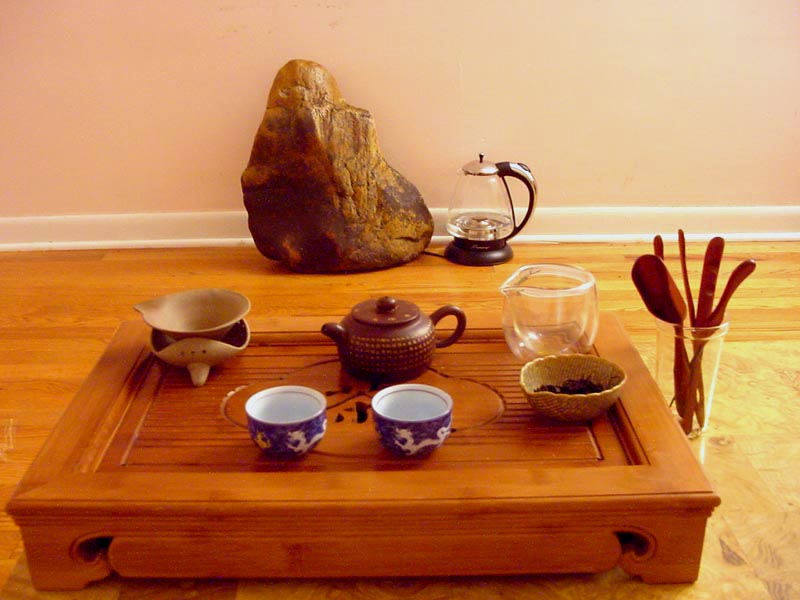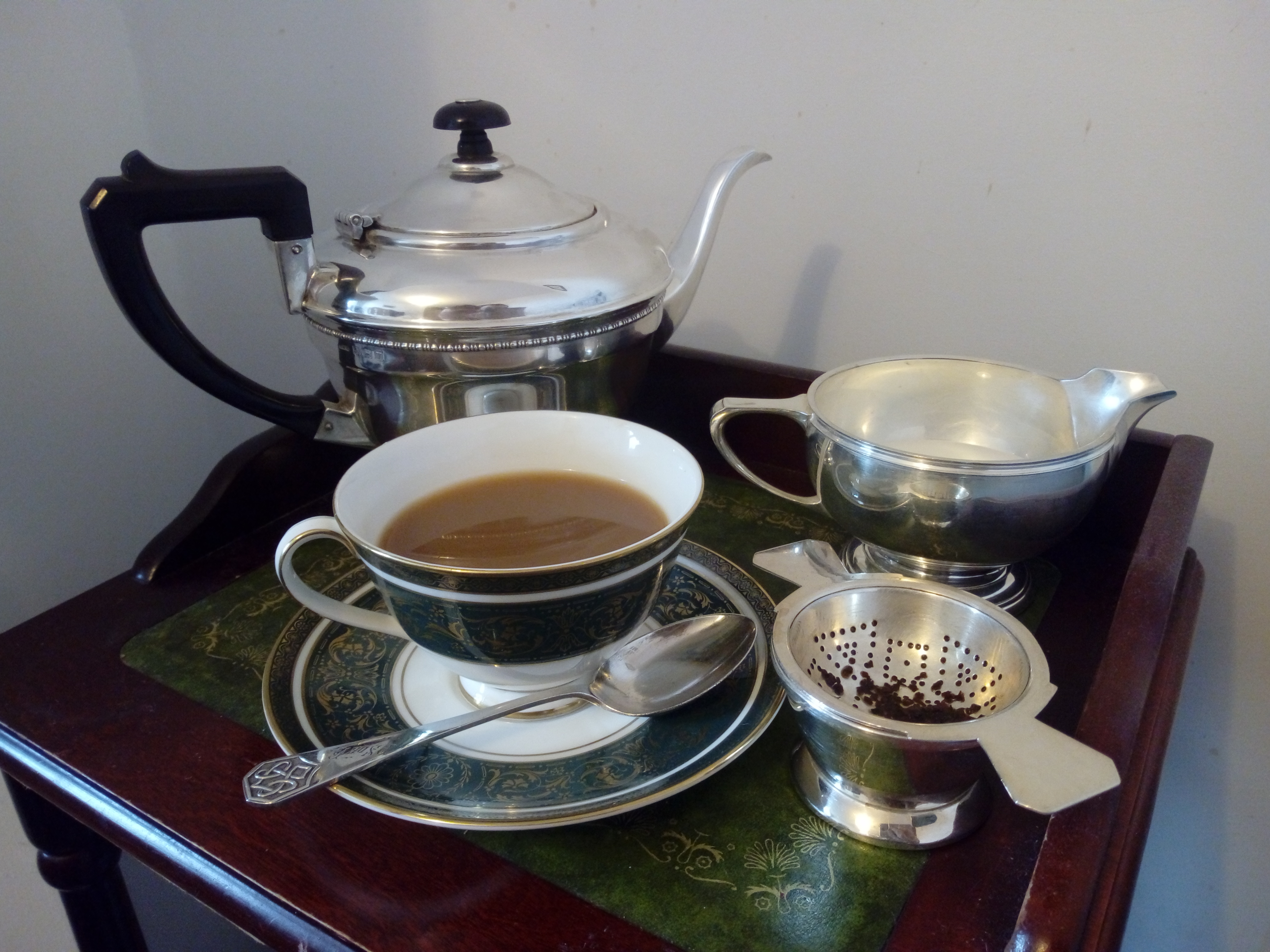|
Tea Draining Tray
A tea draining tray, tea tray, Gongfu tea tray, or tea sea is an integral piece of equipment for the Gongfu tea ceremony. It is essentially a grate, which allows excess and waste liquids to be drained away, and either collected in a pan under the grate, or drained away through a hose that carries the waste water and tea to a bucket or other drain. The Gongfu tea method is used to brew primarily oolong and pu-erh teas. A drain system is especially important with pu-erh teas since the first two pots of tea are usually used to soak the tea, and prime the vessels. The tray is also important because the Gongfu style of brewing is messy and wet. All the cups, pots and other serving items are repeatedly rinsed in hot water and tea to ensure that proper temperatures are kept and that the vessels are sanitary, without watering down the tea. When making tea this way, a pot of tea will be brewed 4–10 rounds. Because it is a wet process, the tea draining tray is necessary to keep the ... [...More Info...] [...Related Items...] OR: [Wikipedia] [Google] [Baidu] |
Gongfu Tea Ceremony
The gongfu tea ceremony or kung fu tea ceremony ( or ), is a type of Chinese tea ceremony, involving the ritual preparation and presentation of tea. It is probably based on the tea preparation approaches originated in Fujian and the Chaoshan area of eastern Guangdong. The term literally means "making tea with skill". The approach often involves using smaller brewing vessels and a higher leaf-to-water ratio than in western-style brewing. Today, the approach is used popularly by teashops carrying tea of Chinese origins, and by tea connoisseurs as a way to maximize the taste of a tea selection, especially a finer one. History Attention to tea-making quality has been a classic Chinese tradition. All teas, loose tea, coarse tea, and powdered tea have long coexisted with the "imperially appointed compressed form". By the end of the 14th century, the more naturalistic "loose leaf" form had become a popular household product and by the Ming era, loose tea was put to imperial use. Th ... [...More Info...] [...Related Items...] OR: [Wikipedia] [Google] [Baidu] |
Oolong
Oolong (, ; (''wūlóngchá'', "dark dragon" tea)) is a traditional semi-oxidized Chinese tea ('' Camellia sinensis)'' produced through a process including withering the plant under strong sun and oxidation before curling and twisting.Zhongguo Chajing pp. 222–234, 271–282, 419–412, chief editor: Chen Zhongmao, publisher: Shanghai Wenhua Chubanshe (Shanghai Cultural Publishers) 1991. Most oolong teas, especially those of fine quality, involve unique tea plant cultivars that are exclusively used for particular varieties. The degree of oxidation, which varies according to the chosen duration of time before firing, can range from 8 to 85%, depending on the variety and production style. Oolong is especially popular in south China and among ethnic Chinese in Southeast Asia as is the Fujian preparation process known as the Gongfu tea ceremony. Different styles of oolong tea can vary widely in flavor. They can be sweet and fruity with honey aromas, or woody and thick with roast ... [...More Info...] [...Related Items...] OR: [Wikipedia] [Google] [Baidu] |
Pu-erh
''Pu'er'' or ''pu-erh'' is a variety of fermented tea traditionally produced in Yunnan Province, China. In the context of traditional Chinese tea production terminology, fermentation refers to microbial fermentation (called 'wet piling'), and is typically applied after the tea leaves have been sufficiently dried and rolled. As the tea undergoes controlled microbial fermentation, it also continues to oxidize, which is also controlled, until the desired flavors are reached. This process produces tea known as 黑茶 ''hēichá'' (lit. 'black tea') (which is different from the English-language ''black tea'' that is called 红茶 ''hóngchá'' (lit. 'red tea') in Chinese). Pu'er falls under a larger category of fermented teas commonly translated as ''dark teas''. Two main styles of pu'er production exist: a traditional, longer production process known as ''shēng'' (''raw'') pu'er; and a modern, accelerated production process known as ''shóu'' (''ripe'') pu'er. Pu'er traditional ... [...More Info...] [...Related Items...] OR: [Wikipedia] [Google] [Baidu] |
Teaware
Teaware is a broad international spectrum of equipment used in the brewing and consumption of tea. Many components make up that spectrum, and vary greatly based upon the type of tea being prepared, and the cultural setting in which it is being prepared. This is often referred to as the ''tea ceremony,'' and holds much significance in many cultures, particularly in northwestern Europe and in eastern Asia. A complete, cohesive collection of tea ware makes up a tea set. Components Alternatives / Others * Mug, instead of tea cup *Coffee cup, instead of tea cup * Chawan, tea bowl from East Asia *Chaki, the caddy for matcha * Japanese tea utensils, used in their tea ceremonies *Tea draining tray, for the Gongfu tea ceremony Construction Tea equipment may be constructed of many materials, from iron in Japan to porcelain and clay in China, and also bamboo and other woods. Of particular repute are the Yixing clay teapots produced in eastern China, a type of Yixing ware. The B ... [...More Info...] [...Related Items...] OR: [Wikipedia] [Google] [Baidu] |
Tea Ceremony
An East Asian tea ceremony, or ''Chádào'' (), or ''Dado'' ( ko, 다도 (茶道)), is a ceremonially ritualized form of making tea (茶 ''cha'') practiced in East Asia by the Chinese, Japanese, and Koreans. The tea ceremony (), literally translated as either "''way of tea''", "''etiquette for tea or tea rite''", or "''art of tea''" in any of the three East Asian languages, is a cultural activity involving the ceremonial preparation and presentation of tea. The Japanese tea ceremony and Korean tea ceremony were influenced by the Chinese tea culture during ancient and medieval times, starting in the 9th century when tea was first introduced to Japan and Korea from China. One can also refer to the whole set of rituals, tools, gestures, etc. used in such ceremonies as tea culture. All of these tea ceremonies and rituals contain "an adoration of the beautiful among the sordid facts of everyday life", as well as refinement, an inner spiritual content, humility, restraint and simp ... [...More Info...] [...Related Items...] OR: [Wikipedia] [Google] [Baidu] |




